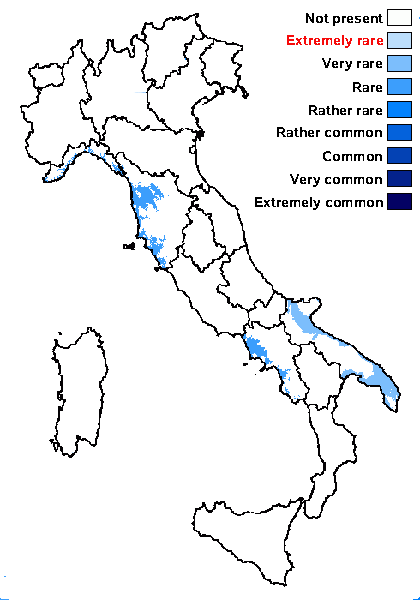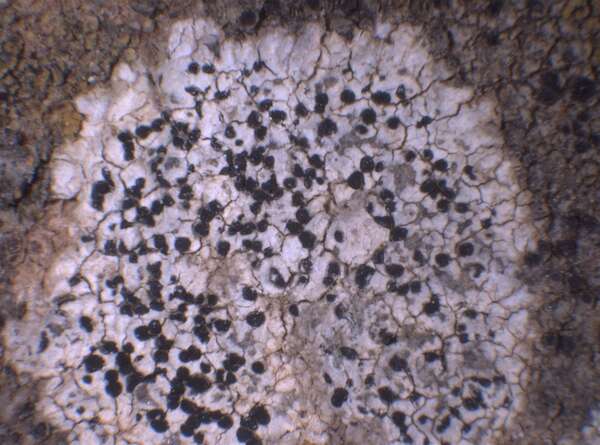Buellia maritima (A. Massal.) Bagl.
in A. Massalongo, Sched. Crit. Lich. Exsicc., 8: 150, 1856. Basionym: Catolechia maritima A. Massal. - Symmicta Lich.: 51, 1855.
Synonyms:
Distribution: N - Lig. C - Tosc. S - Camp, Pugl (TSB 7645, 32354).
Description: Thallus crustose, episubstratic, chalky white to rarely pale grey, heavily pruinose, continuous, rimose or more rarely rimose-areolate, forming often confluent patches sometimes delimited by a dark to whitish boundary line. Phenocortex overlain by a thick epinecral layer filled with calcium oxalate crystals; medulla chalky white, also filled with crystals. Apothecia black, lecideine to rarely pseudolecanorine (surrounded by an outer ring of poorly differentiated thalline collar), 0.2-0.7 mm across, at first immersed, then adnate to sessile, with an epruinose or whitish pruinose, flat to finally convex disc and a thin, usually persistent proper margin. Proper exciple very thin, Aethalea-type, the inner hyphae hyaline, prosoplectenchymatous (resembling paraphyses), the outer hyphae parallel, moderately swollen and usually strongly pigmented with brown and aeruginose pigments, N+ violet; epithecium brown, N+ violet; hymenium hyaline, not inspersed with oil droplets; paraphyses simple to sparingly branched, the apical cells swollen, with a brown cap; hypothecium dark reddish brown. Asci 8-spored, clavate to cylindrical-clavate, the apical dome K/I+ dark blue with a pale, conical-pointed apical cushion (axial mass), the wall I-, but the thin outer gel I+ blue, Bacidia-type. Ascospores 1-septate, brown, narrowly oblong to ellipsoid, not constricted at septum, 8-15 x 4-8 µm, Buellia-type, the wall smooth. Pycnidia rare, globose, black, immersed in the thallus. Conidia bacilliform, 2.5-4 x 1.5-1.5 µm. Photobiont chlorococcoid. Spot tests: thallus K+ yellow turning red (needle-like crystals), C-, KC-, P+ yellow. Chemistry: norstictic and connorstictic acids.
Note: this calcicolous, mainly coastal species was considered by Scheidegger (1993) as a synonym of B. stellulata, which differs substantially in morphology, chemistry and ecology. Jatta (1909-1911) treated the two species separately.
Growth form: Crustose
Substrata: rocks
Photobiont: green algae other than Trentepohlia
Reproductive strategy: mainly sexual
Taxon bound to maritime-coastal situations
Commonnes-rarity: (info)
Alpine belt: absent
Subalpine belt: absent
Oromediterranean belt: absent
Montane belt: absent
Submediterranean belt: absent
Padanian area: absent
Humid submediterranean belt: absent
Humid mediterranean belt: rare
Dry mediterranean belt: very rare

Predictive model
Growth form: Crustose
Substrata: rocks
Photobiont: green algae other than Trentepohlia
Reproductive strategy: mainly sexual
Taxon bound to maritime-coastal situations
Commonnes-rarity: (info)
Alpine belt: absent
Subalpine belt: absent
Oromediterranean belt: absent
Montane belt: absent
Submediterranean belt: absent
Padanian area: absent
Humid submediterranean belt: absent
Humid mediterranean belt: rare
Dry mediterranean belt: very rare

Predictive model




